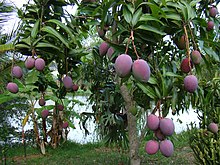Tommy Atkins (mango): Difference between revisions
m Bot: link syntax/spacing |
added history section |
||
| Line 6: | Line 6: | ||
Tommy Atkins are very similar to the [[Sub-continent|sub-continental]] cultivar Fajri, which are the last mangoes of the season, particularly in [[Pakistan]] and are conventionally used for animal feed and processing and are generally not considered fit for human consumption.{{By whom|date=May 2011}} |
Tommy Atkins are very similar to the [[Sub-continent|sub-continental]] cultivar Fajri, which are the last mangoes of the season, particularly in [[Pakistan]] and are conventionally used for animal feed and processing and are generally not considered fit for human consumption.{{By whom|date=May 2011}} |
||
== History == |
|||
The original tree reportedly grew from a '[[Haden (mango)|Haden]]' seed planted around 1922 on the property of Thomas H. Atkins of [[Broward County, Florida]]. Later pedigree analysis supported the 'Haden' parentage of 'Tommy Atkins'. Thomas Atkins submitted the fruit to the variety committee of the Florida Mango Forum multiple times during the 1950s, which rejected it due to its unremarkable eating qualities and considerable fiber in the flesh. Atkins, however, felt strongly that the fruit had good commercial potential due to its color, strong and steady production, relatively good fungus resistance, and good handling characteristics. He was able to market the fruit successfully to commercial growers, who began planting the cultivar during the 1950s. Thereafter, 'Tommy Atkins' became extremely popular as a commercial variety, eventually becoming the most commonly planted commercial mango in Florida, and later the most extensively planted in the Americas<ref>{{cite book |title= A Guide to Mangos in Florida|last=Campbell |first= Richard J.|authorlink= |coauthors= |year=1992 |publisher=Fairchild Tropical Garden |location= |isbn=0-9632264-0-1 |page=173 |pages= |url= |accessdate=March 4, 2012}}</ref>, a position it still holds today. |
|||
==References== |
==References== |
||
{{Reflist}} |
{{Reflist}} |
||
Revision as of 00:20, 5 March 2012

Tommy Atkins is the most important mango cultivar in global trade[citation needed]. Although generally not considered to be the best in terms of sweetness and flavor,[1] it is valued for its very long shelf life and tolerance of handling and transportation with little or no bruising or degradation.[2]
This means it is the main mango sold in regions where mangoes have to be imported, comprising about 80% of mangoes sold in the United Kingdom and United States[dubious – discuss], apart from growing regions in Hawaii and Florida. However in France it is sold at a discount, while the main imported cultivar is Kent[3], considered less fibrous and tastier.
Tommy Atkins are very similar to the sub-continental cultivar Fajri, which are the last mangoes of the season, particularly in Pakistan and are conventionally used for animal feed and processing and are generally not considered fit for human consumption.[by whom?]
History
The original tree reportedly grew from a 'Haden' seed planted around 1922 on the property of Thomas H. Atkins of Broward County, Florida. Later pedigree analysis supported the 'Haden' parentage of 'Tommy Atkins'. Thomas Atkins submitted the fruit to the variety committee of the Florida Mango Forum multiple times during the 1950s, which rejected it due to its unremarkable eating qualities and considerable fiber in the flesh. Atkins, however, felt strongly that the fruit had good commercial potential due to its color, strong and steady production, relatively good fungus resistance, and good handling characteristics. He was able to market the fruit successfully to commercial growers, who began planting the cultivar during the 1950s. Thereafter, 'Tommy Atkins' became extremely popular as a commercial variety, eventually becoming the most commonly planted commercial mango in Florida, and later the most extensively planted in the Americas[4], a position it still holds today.
References
- ^ Stanley, Tyler (1998). Diet By Design: Fruits, Nuts, And Natural Foods. TEACH Services, Inc. p. 118. ISBN 1572580968, 9781572580961.
{{cite book}}: Check|isbn=value: invalid character (help) - ^ Susser, Allen; Schneider, Greg (2001). The Great Mango Book. Ten Speed Press. p. 52. ISBN 1580082041, 9781580082044.
{{cite book}}: Check|isbn=value: invalid character (help) - ^ [1] Source of Sept 2009 consulted on 21/10/2011
- ^ Campbell, Richard J. (1992). A Guide to Mangos in Florida. Fairchild Tropical Garden. p. 173. ISBN 0-9632264-0-1.
{{cite book}}:|access-date=requires|url=(help); Cite has empty unknown parameter:|coauthors=(help)

